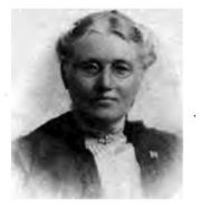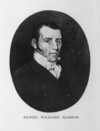
Source: Link
FAULKNER, MATILDA MOORE (Churchill), schoolteacher, Baptist missionary, and author; b. October or November 1840 in Stewiacke, N.S., daughter of William Faulkner, an engineer, and Nancy Woodworth; m. 16 Sept. 1873 the Reverend George Churchill, a Baptist minister, in Truro, N.S., and they had two sons and two daughters, of whom one daughter survived to adulthood; d. 12 Aug. 1924 in Toronto.
Matilda Faulkner was born and raised in Stewiacke. In her teens her family moved to Truro, where she attended the Model and Normal schools, obtaining a first-class teacher’s licence in 1861. At first she taught primary and intermediate classes in Merigomish and at the Model School in Truro; later she moved to the senior department of the Model School, as one of the first Normal School-trained high-school teachers. She also volunteered among the poor, establishing church services and a night school for the black Baptist population of Truro. At the same time she harboured a desire to be an overseas missionary, which she later declared had been instilled in her at the age of 14 after a series of “wonderful meetings” in Stewiacke during which she and members of her family had been baptized.
At first her attempts to serve as a foreign missionary were discouraged since she was a single woman. An opportunity arose in 1871, however, when George Churchill, whom she had met as a student in Truro, asked her to be his wife and accompany him to do missionary work in Asia. After studies at the Woman’s Medical College in Philadelphia, she was married and in October 1873 she and her husband joined a group of missionaries – known as the “serving seven” [see Mary E. Lamont*] – who had been appointed by the Baptist Foreign Mission Board to go to Burma, where Hannah Maria Norris* was already labouring, and Siam. There were difficulties with the southeast Asian location, however, and at the 1875 meeting of the Baptist Convention of Nova Scotia, New Brunswick and Prince Edward Island a new field was chosen. It was the Telugu country on the western shore of the Bay of Bengal. This decision marked the beginning of Maritime Baptist involvement in India, which has continued to the present.
The Churchills served first at Cocanada (Kakinada) and Bimlipatam, before establishing their own mission station at Bobbili in 1879. Encountering numerous challenges such as the heat, language and cultural barriers, primitive living conditions, and the difficult caste system, Matilda and her husband nonetheless persevered. In 1875 she described villages of mud huts, mainly pariah settlements, where the women she sought to teach were “filthy and ragged, their hair matted, and so forlorn and despairing looking; not pleasant to labour with, nor are their children.” Generally the women missionaries worked with women and children, establishing schools and promoting literacy, while the men worked with the men, training some as native preachers. One of Matilda’s accomplishments was founding and managing a “Caste Girls’ School,” in a new building in Bobbili in 1880, which taught mostly Brahman girls. She had previously run a similar establishment in rented premises in Bimlipatam.
Matilda served as a missionary in India from 1875 to 1921, except for brief periods when she returned to Canada or made trips abroad. During her years there she lost three children and, in 1908, her husband. She nevertheless carried on until February 1921, when she went to Toronto to live with her daughter, Elizabeth Maud Stillwell, who had also served as a missionary in India. She died there in 1924 at the age of 83 years 10 months and was buried in Mount Pleasant Cemetery. One obituary observed that she was “a woman of sound judgment, intense spirituality and possessed a most winning personality, which qualities made her an outstanding figure in the missionary personnel of her day.” She had been awarded an honorary ma in 1923 by Acadia University in Wolfville, N.S., a recognition that her husband had achieved in 1899.
Matilda’s significance lies not only in her pioneering missionary efforts, but also in her literary legacy. In 1916 Letters from my home in India was published, a compilation arranged and edited by Grace Dean McLeod Rogers. With rare insights into the methods and mentality of women missionaries, the letters reveal Matilda’s steady determination in the face of enormous difficulties and her quiet acceptance of disappointments, personal losses, and, eventually, the infirmities of old age. Her descriptions of her work testify to the special relationships she developed with native women, despite her sharing the patronizing racial attitudes of the British community in India. Her attempts to improve both the spiritual and the physical lot of the natives may be evidence as well of what some historians have called “maternal feminism,” the view that women were to be the saviours of society. As Matilda put it, “Give us right-minded, high-souled women, and we will have righteous noble men and children.” Like most of her contemporaries, Matilda saw her missionary work as an extension of the accepted womanly roles of homemaking, caregiving, and teaching. The feminism of many Nova Scotian women like Churchill, however, was defined by their Christian sensibilities. Summing up her career in 1916, Matilda said, “Often have I failed, sometimes almost faltered, but never have I desired to be aught but a disciple of Christ, privileged indeed to be bearer of His message of light and love to heathen lands.”
Matilda Faulkner Churchill’s Letters from my home in India: being the correspondence of Mrs. George Churchill (1871–1916), ed. G. [D.] McLeod Rogers was published in both New York and Toronto in 1916 and was reprinted in Toronto in 1924. Selections from the letters for 1871–79 have been reprinted in Margaret Conrad, “Mathilda Faulkner Churchill, 1840–1925,” in No place like home: diaries and letters of Nova Scotia women, 1771–1938, ed. Margaret Conrad et al. (Halifax, 1988), 122–33. Churchill is also the author of Reminiscences of Willie Chandler Churchill by his mother (Saint John, 1882).
AO, RG 80-8-0-950, no.4892. Little White Schoolhouse Museum (Truro, N.S.), Registers for Normal School. NSARM, RG 32, WB, Colchester County, no.142/1873; Index to the 1871 census of Colchester County, Nova Scotia (n.p., n.d.). Acadian Recorder (Halifax), 15 Aug. 1924. Maritime Baptist (Saint John), 27 Aug. 1924. Morning Chronicle (Halifax), 15 Aug. 1924. Truro Daily News, 19 Aug. 1924. Baptist year book of the Maritime provinces of Canada . . . (Halifax; Saint John, N.B.), 1873–1905, reports of the Foreign Missionary Board. Margaret Conrad, “Recording angels: the private chronicles of women from the Maritime provinces of Canada, 1750–1950,” in Canadian Research Institute for the Advancement of Women, Papers (Ottawa), no.4 (1982): 12. Directory, N.S., 1866/67, 1868/69, 1871. M. K. Ingraham, Seventy-five years: historical sketch of the United Baptist Woman’s Missionary Union in the Maritime provinces of Canada (Kentville, N.S., [1947?]). G. E. Levy, The Baptists of the Maritime provinces, 1753–1946 (Saint John, 1946). R. K. McCormick, Faith, freedom & democracy: the Baptists in Atlantic Canada (Tantallon, N.S., 1993). John March, A brief history of the foreign missionary enterprise among the Baptists of the Maritime provinces, of the Dominion of Canada (Saint John, 1892; 2nd ed., rev. J. W. Manning, 1899). Mrs C. H. Martell et al., Historical sketch of the United Baptist Woman’s Missionary Union of the Maritime provinces . . . (Wolfville, N.S., n.d.). E. C. Merrick, These impossible women, 100 years: the story of the United Baptist Woman’s Missionary Union of the Atlantic provinces ([Fredericton], 1970). Wendy Mitchinson, “Canadian women and church missionary societies in the nineteenth century: a step towards independence,” Atlantis (Wolfville), 2 (1976–77), no.2, pt.2: 57–75. N.S., Council of Public Instruction, Annual report of the superintendent of education (Halifax), 1864: 40. N.S. vital statistics, 1835–39 (Holder) no.2135. Register and circular with brief history and condition of the Normal School of Nova-Scotia, 1862 ([Halifax, 1862?]). H. M. Ross, “‘Sisters’ in the homeland: vision for mission among Maritime Baptist women, 1867–1920,” in A fragile stability: definition and redefinition of Maritime Baptist identity, ed. D. T. Priestly (Hantsport, N.S., 1994), 95–112 . United Baptist year book (Saint John), 1906–24.
© 2005–2024 University of Toronto/Université Laval
Image Gallery

Cite This Article
Wendy L. Thorpe, “FAULKNER, MATILDA MOORE (Churchill),” in Dictionary of Canadian Biography, vol. 15, University of Toronto/Université Laval, 2003–, accessed April 23, 2024, http://www.biographi.ca/en/bio/faulkner_matilda_moore_15E.html.
The citation above shows the format for footnotes and endnotes according to the Chicago manual of style (16th edition). Information to be used in other citation formats:
| Permalink: | http://www.biographi.ca/en/bio/faulkner_matilda_moore_15E.html |
| Author of Article: | Wendy L. Thorpe |
| Title of Article: | FAULKNER, MATILDA MOORE (Churchill) |
| Publication Name: | Dictionary of Canadian Biography, vol. 15 |
| Publisher: | University of Toronto/Université Laval |
| Year of publication: | 2005 |
| Year of revision: | 2005 |
| Access Date: | April 23, 2024 |







